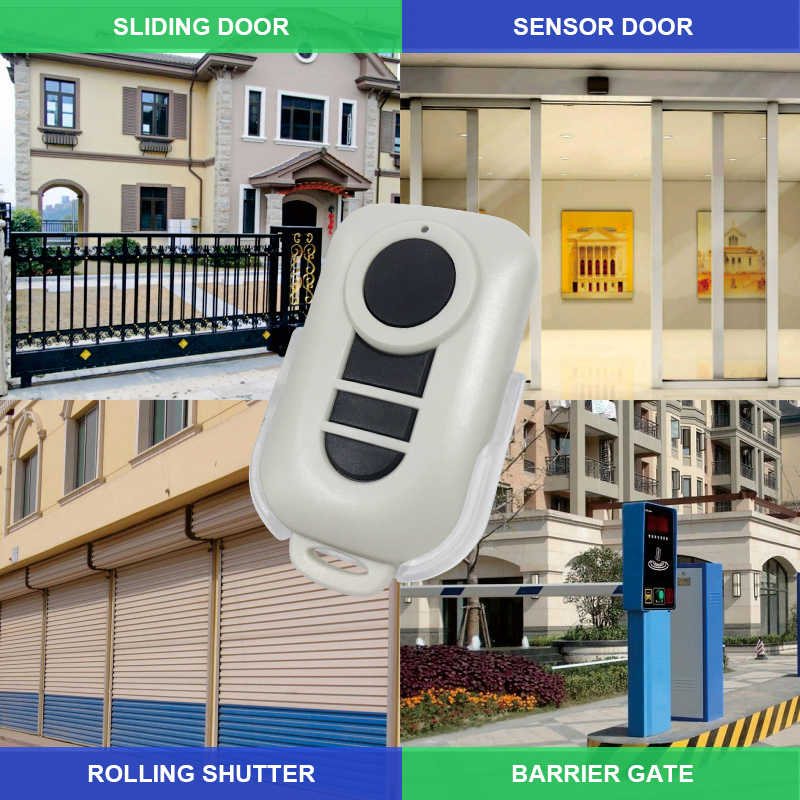Garage door remote controls are essential tools in modern homes, providing convenience by wirelessly controlling garage doors. As technology advances and user needs evolve, the materials and design of these remotes have also improved. The durability of a remote control significantly depends on its materials and design. For frequently used garage door remotes, factors like water resistance, dust resistance, and impact resistance become crucial. Durable remotes not only extend the product's lifespan but also reduce the frequency of repairs and replacements. This article explores how the materials and design of garage door remotes impact their durability and offers guidance on selecting a long-lasting remote control.

1. Materials of Remote Controls
The durability of a remote control is greatly influenced by the materials used. High-quality materials enhance both the lifespan of the remote and its ability to withstand environmental factors. Here are some common materials used in remote controls and their characteristics:
1.1 Housing Materials
The housing of a remote control protects the internal electronic components. Common housing materials include:
Plastic: Plastic is the most common material for remote control housings. High-quality plastics (such as ABS or polycarbonate) offer good impact resistance and aging performance. ABS plastic is durable and cost-effective, suitable for most standard remotes. Polycarbonate plastic, on the other hand, provides better impact resistance and high-temperature performance, making it ideal for high-end or specialized remotes.
Metal: Metal housings (such as aluminum alloy) are often used in high-end remotes. Metal not only provides greater durability and sturdiness but also excellent heat dissipation. However, metal housings can increase the weight of the remote and are generally more expensive.
1.2 Button Materials
The materials used for the buttons on a remote control affect both user comfort and button durability. Common button materials include:
Silicone: Silicone buttons offer good elasticity and wear resistance, making them capable of withstanding frequent use. Silicone also provides decent water resistance, ensuring the remote works properly in damp environments.
Rubber: Rubber buttons are typically softer, providing a comfortable feel and good grip. However, rubber materials may have lower durability and resistance to aging, which can lead to wear over time.
1.3 Internal Circuit Boards
The internal circuit boards of remotes usually use high-quality epoxy resin and copper materials. Epoxy resin provides good insulation and high-temperature resistance, while copper ensures excellent electrical conductivity. High-end remotes may also include shielding layers to enhance resistance to interference.
2. Design Considerations for Remote Controls
In addition to materials, the design of a remote control plays a critical role in its durability and functionality. Key design factors include:
2.1 Water and Dust Resistance
Water and dust resistance is essential for ensuring that the remote performs reliably under various environmental conditions. Common protective designs include:
Sealing Design: Water and dust-resistant remotes often feature sealing designs, such as gaskets and protective covers. These designs effectively prevent moisture and dust from entering the remote, thereby protecting the internal components.
Protective Covers: Some remotes come with protective covers that shield the button area from water and dust. These covers are usually made of soft rubber or silicone, providing protection without compromising ease of use.
2.2 Impact Resistance
Impact resistance is crucial for ensuring that the remote functions correctly even after accidental drops or collisions. Common impact-resistant designs include:
Reinforced Housing: Remotes with reinforced or double-layered housings offer increased impact resistance. Some remotes also include additional cushioning materials inside the housing to reduce the impact on internal components.
Anti-Slip Design: To prevent the remote from slipping during use, some designs incorporate anti-slip textures or rubber grips. These features enhance stability and prevent accidental drops.
2.3 Ergonomic Design
Ergonomic design focuses on user comfort and ease of operation. Key ergonomic features include:
Hand-Shaped Curves: The remote’s shape should conform to the natural curves of the hand, making it comfortable to hold and operate.
Logical Button Layout: The arrangement of buttons should match the user’s operational habits, making frequently used buttons easy to reach and operate.
3. Impact of Materials and Design on Remote Durability
3.1 Enhancing Durability
High-quality materials and well-thought-out designs directly contribute to the durability of remote controls. Durable remotes are capable of performing reliably in harsh conditions, reducing the need for frequent repairs and replacements. Specific benefits include:
Water Resistance: Waterproof designs ensure that the remote can be used in rainy or humid conditions without malfunctioning, preventing issues such as short circuits or corrosion.
Dust Resistance: Dust-resistant designs prevent dust and debris from entering the remote, keeping internal circuits clean and operational.
Impact Resistance: Impact-resistant designs protect the remote from damage during drops or collisions, preserving the integrity of internal components.
3.2 Extending Product Lifespan
By selecting durable materials and designs, users can significantly extend the lifespan of their remote controls. For instance, remotes with high-quality plastic or metal housings, along with effective water, dust, and impact protection, generally offer longer service lives and enhanced functionality.
4. Recommendations for Selecting Durable Remote Controls
4.1 Consider Environmental Conditions
When choosing a remote control, consider the environment in which it will be used. For remotes exposed to damp or dusty conditions, selecting one with robust water and dust resistance features is crucial.
4.2 Evaluate Material Quality
Pay attention to the quality of the remote’s materials. High-grade plastics or metals, durable button materials, and robust internal circuit boards are key factors in ensuring the remote’s longevity and performance.
4.3 Check Design Details
Examine the design details of the remote, such as sealing mechanisms, impact-resistant features, and ergonomic design elements. These details determine how well the remote performs and how comfortable it is to use.
5. Conclusion
The materials and design of garage door remote controls are vital in determining their durability and functionality. High-quality materials and thoughtful design features enhance water resistance, dust resistance, and impact resistance, leading to a longer product lifespan and reduced maintenance needs. Choosing a suitable remote control ensures reliable performance under various environmental conditions and improves user convenience.
As technology continues to evolve, future remote controls are likely to see further innovations in materials and design to meet diverse user needs. When purchasing a remote control, users should consider material quality, design details, and environmental conditions to select the best product for their requirements.

-
Office ViewQinuo Electronics Co., Ltd.was founded in 2009,it is a high-tech company that integrated R & D, manufacturing, sales and service for 15 years,which is mainly specialized in providing sensors of automatic door, control system of door and gate, car key remote, auto parts etc. The company currently has four independent brands: U-CONTROL, U-SENSORS, U-AUTOGATES and U-AUTOKEYS.
-
got questions? call us
+86 13960286508
-
fax :
+86 595 22901208 -
Email :
[email protected]
-
address
- No.991 Xingxiu Road,Taiwanese Investment Zone, Quanzhou, Fujian Province,P.R.China











